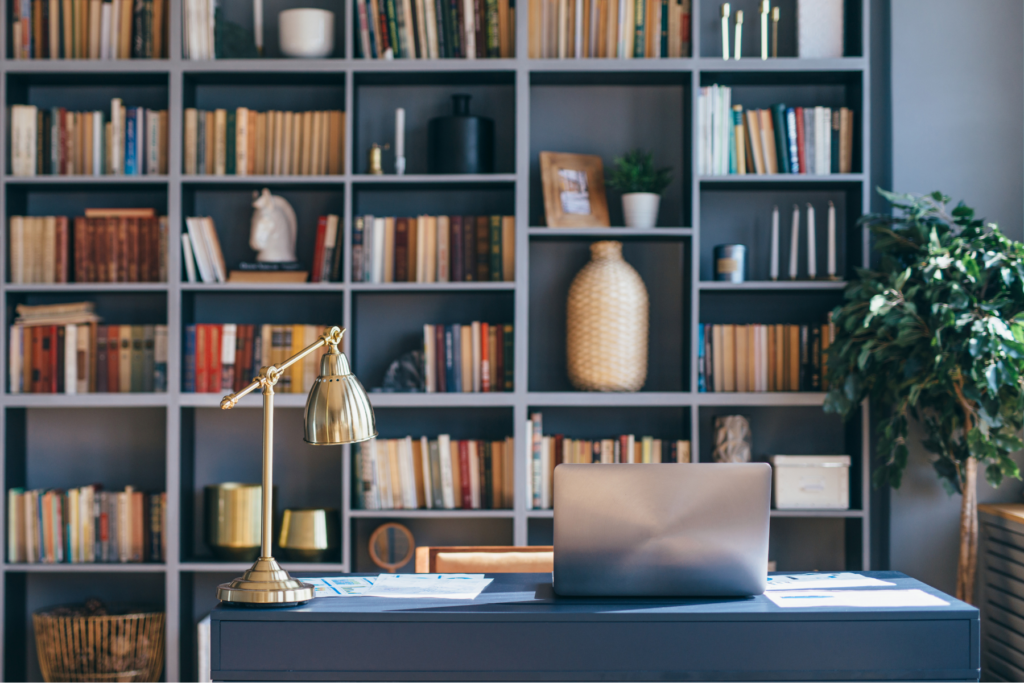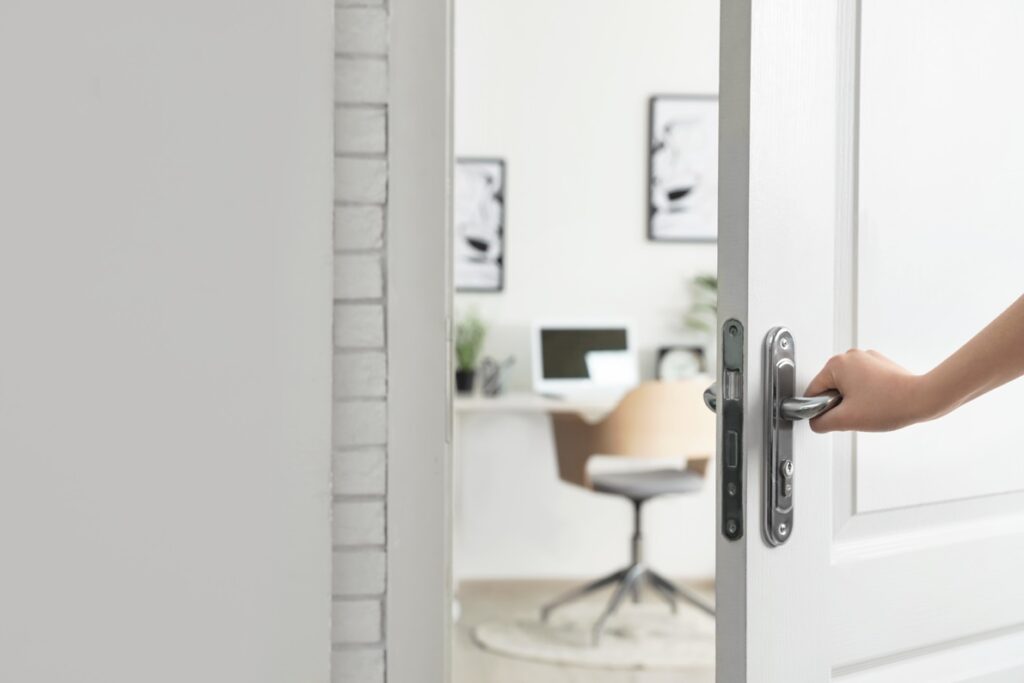
In our last blog we looked into some of the major features of a home office: flooring, lighting, and paint color. This time around we’ll be talking about the homier aspects of your office that make it feel more comfortable and livable: sound proofing, storage, and furniture.

Sound Proofing
- Sometimes the hustle and bustle inside and outside of your house can interrupt your work day. Ideally, you’ll want as much peace and quiet as possible in your home office so you can focus on your work. There are many ways to sound-proof your office, many of which are fairly simple.
- Use a door sweep and/or weather stripping on your door.
- If your office has a hollow-core door, consider replacing it with a solid wood or decorative fiberglass door. Hollow-core doors are more common in homes today as they are more affordable. Solid-core doors will absorb more of the exterior noise, preventing it from entering the room. LaValley/Middleton recommends urethane-core fiberglass doors from Therma-Tru. In addition to their good looks, Therma-Tru core doors are great insulators.
- Add rugs to your floor. Sound bounces off hard surfaces, especially the floor. Adding one or two thick, soft rugs will help dampen the noise.
- Use all-purpose caulk to seal open spaces around outlets and ducts. DAP caulking and sealing products can be found at all LaValley/Middleton locations.
- If your office has a high ceiling or is on a lower level of your home, consider installing a drop ceiling and insulating the space in between the two ceilings with high-density insulation.
- When furnishing your office space, consider choosing upholstered/padded furniture rather than hardwood furniture. Similar to adding rugs to the hardwood floor, upholstered furniture absorbs sound to prevent excessive noise and echo.
Storage

- The most important thing to consider when choosing cabinetry and storage for your home office is the amount of floor space that is available. Vertical cabinets are best for smaller spaces, while horizontal cabinets are best for larger spaces.
- It is ideal to have a mix of open and closed storage in your home office. Open storage allows you to access what you need more easily while closed storage prevents the room from looking and feeling too cluttered. Consider the ideas below when choosing your office storage. The goal is to maintain balance between convenient accessibility and a nicely-organized presentation.
- Maintain separation between your workspace and storage space. Cluttering your workspace (i.e., your desk) with file storage or décor can hinder productivity due to lack of space.
- Utilize empty wall space to mount folders, file organizers, and/or floating shelves to free up your workspace. This method is especially useful if you are working in a small space or are on a tight budget.
- Choose a desk with built-in storage. If you can spare the space, consider using a desk that has built in drawers or filing systems. This can keep your workspace tidy while still keeping all of your necessary supplies within arm’s reach.
- Use closet storage to your advantage. If you’re using a spare bedroom as your home office, you likely have access to a closet that can be used to organize your materials.
- Invest in storage cabinets. There are countless design options for functional storage and filing cabinets for different budgets. LaValley/Middleton offers cabinets from a variety of different vendors including KraftMaid, Plain & Fancy, and Medallion.
Furniture

Desk
It is important to prioritize practicality and functionality when choosing furniture for your home office. Your desk is likely where you will be spending a lot of your time throughout the work day. However, many people often choose a desk that is too large or too small for the space they are working in. To avoid this mistake, determine the needs of the workspace and plan the rest of the room accordingly. This will also help to free up space throughout the rest of the room. Other desk-related design mistakes can be found below.
Mistake: placing your desk in front of a window. This blocks natural light from entering the room, reduces contrast on your computer screen, and causes eyestrain due to prolonged squinting.
Solution: Move desk away from the window or use curtains.
Mistake: Placing your desk in front of a wall.
Solution: Your desk should be placed in a “command position”, facing the door so that you can see who is entering and exiting your office. A floating position in the middle of the room is ideal, but if that is not practical, place the desk along the same wall as the entry door.
Desk Chair
A good desk chair is just as important as the desk itself. Afterall, you will likely be sitting in your desk chair for the majority of the day. Investing in an ergonomic chair that provides lumbar support will pay off in the long run and help you stay comfortable and productive throughout the work week. If you’re on a budget, you can purchase a lumbar support pillow for the back of your existing chair instead.
A home office is a personalized area that is meant to elicit inspiration and productivity. The colors, styles, and designs that you choose are intended to propel you into an energized mindset. Following the tips listed above, along with the tips in part one of this blog, can help you put together an office that has everything you need to get your work done.
Visit one of LaValley/Middleton’s 12 locations throughout New Hampshire and Vermont for everything you need to put together your new home office.
Click to view sources for this blog.
See more from the blog! Check out our latest posts…



